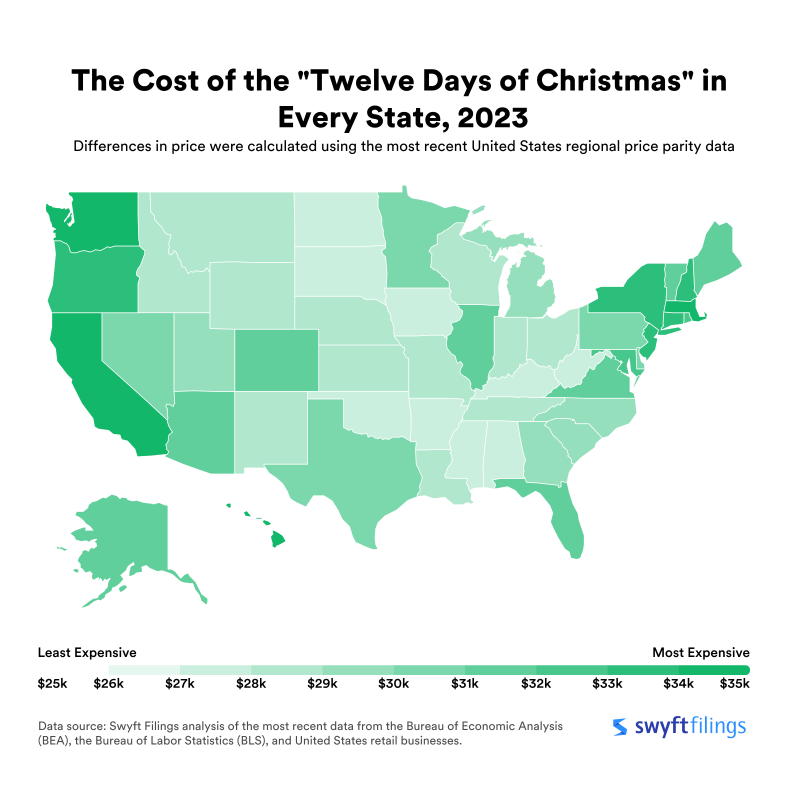How much do the “Twelve Days of Christmas” cost in your state?

How much do the “Twelve Days of Christmas” cost in your state?
“The Twelve Days of Christmas,” a timeless holiday carol with roots dating back to 18th-century England, has captivated generations of both carolers and the less musically inclined. This enduring song, with its whimsical lyrics and festive spirit, cycles through twelve days of extravagant gift-giving, from pear trees to dancers and an abundance of birds. While its true meaning and symbolism have been the subject of much debate, it undeniably represents the joy and generosity that define the holiday season.
Americans are indeed generous during this time of year, although most won’t be splurging to the extravagant tune of “The Twelve Days of Christmas.” In fact, the average American plans to spend $875 on gifts this holiday season, according to the most recent data from the National Retail Federation.
Regionally, the cost of goods can vary significantly, and a dollar goes much further in some states than others. Regional price parity (RPP) is a measure that quantifies these variations by comparing the price levels for a similar basket of goods and services within specific areas, providing insights into how price levels differ from state to state.
As such, the cost of all the gifts listed in the “Twelve Days of Christmas” would be quite different depending on where they were purchased. To estimate these prices by state, the research team at Swyft Filings, a business filing service, referred to the most recent data from the Bureau of Economic Analysis and the Bureau of Labor Statistics.
![]()

Here are the key findings from our analysis
- National average: This year, the national average cost of all gifts listed in the “Twelve Days of Christmas” is $31,243.
- The cost of all repetitions of the song: Calculating the cost of all gifts by including their respective repetitions in the song would result in a total of 364 gifts. This amounts to a staggering $148,138, which is 2.6 times as high as the average full-time salary in 2023.
- The most and least expensive states: California, Hawaii, and Washington were the three most expensive states, with the cost of all gifts landing at $35,148, $34,617, and $34,305, respectively. On the other hand, Arkansas, Mississippi, and Alabama were the three least expensive, with the total cost of gifts at $27,056, $27,275, and $27,431, respectively.
- The most and least expensive gifts: While five gold rings may seem like the most costly of all twelve gifts, it may be surprising to find that the “seven swans a-swimming” cost the most by far, coming in at $10,983. By comparison, the partridge in a pear tree is the least expensive gift at just under $89.
The average cost of each gift
A Partridge in a Pear Tree
- National average cost: $89
- Total cost for all repetitions of the song: $1,064
The first day of the Twelve Days of Christmas starts on a modest note, at just $89 total. This figure includes the partridge, which costs just $14, and the pear tree, which costs $75.
Two Turtle Doves
- National average cost: $184
- Total cost for all repetitions of the song: $2,027
Love, hope, and peace take center stage on the second day of Christmas. This avian duo is also the second-most affordable gift of all twelve days. Nevertheless, their cost, while modest compared to the extravagant gifts on days three through twelve, is more than double that of the partridge in a pear tree.
Three French Hens
- National average cost: $718
- Total cost for all repetitions of the song: $7,177
While the specific type of “French hen” mentioned in the carol remains unclear, Bresse hens were chosen for this analysis. The Bresse chicken is a traditional French breed originating from the Rhone-Alpes region. Their red crests, white bodies, and blue legs are also reminiscent of the tricolored French flag.
Four Calling Birds
- National average cost: $651
- Total cost for all repetitions of the song: $5,856
This gift has been the subject of ongoing debate, as the two most common versions of this line in the carol are “four calling birds” and “four colly birds.” The difference lies in the interpretation. “Colly birds” are an outdated term for blackbirds, while “calling birds” could be interpreted to mean songbirds in general. For this analysis, a blackbird (which is a type of songbird) was chosen to satisfy both interpretations.
Five Gold Rings
- National average cost: $3,844
- Total cost for all repetitions of the song: $30,754
Originally, these rings may have referred to pheasants due to the ring-like markings around their necks, but nowadays, “five gold rings” is interpreted literally. It’s important to note that the cost of gold rings can vary significantly, influenced by factors like style, ring size, weight, and karat. A 14-karat plain gold band was selected for this analysis due to its wide availability and representation as a balanced middle ground between 10-karat and 18-karat alternatives.
Six Geese A-Laying
- National average cost: $273
- Total cost for all repetitions of the song: $1,910
Among all the gifts in “The Twelve Days of Christmas,” “six geese a-laying” is the third-most affordable, totaling $273. If comparing the price per bird, geese were the second-most economical choice of all the birds, behind partridges which cost $14.
Seven Swans A-Swimming
- National average cost: $10,983
- Total cost for all repetitions of the song: $65,898
The “seven swans a-swimming” are the most extravagant gift among the twelve days at $10,983, with each swan carrying a hefty price tag of $1,569. In fact, they cost more than double the gold rings, which were $769 each.
Eight Maids A-Milking
- National average cost: $1,117
- Total cost for all repetitions of the song: $5,584
The inclusion of the “eight maids a-milking” in the carol is somewhat curious since they seem out of place among the lords, ladies, and musical performers – although they may represent the idea of giving practical gifts. The average hourly wage for these dairy workers is $17.45, which totals to $1,117 for eight working a full 8-hour day.[11]
Nine Ladies Dancing
- National average cost: $1,773
- Total cost for all repetitions of the song: $7,091
While costing over $600 more than the “eight maids a-milking,” the “nine ladies dancing” are actually the lowest-paid performers in the carol. The average hourly wage for dancers in the United States is $24.62, which equates to $196.96 per day for each dancer.
Ten Lords A-Leaping
- National average cost: $2,374
- Total cost for all repetitions of the song: $7,121
The true meaning of the “ten lords a-leaping” in the Twelve Days of Christmas is a mystery, although they may represent joy and merriment. Given that they are described as “leaping,” they were categorized as acrobats or performers in this analysis. These capable entertainers earn an average wage of $29.67 per hour or $237.36 per day per performer.
Eleven Pipers Piping
- National average cost: $4,418
- Total cost for all repetitions of the song: $8,837
Music is an integral part of the holiday season, bringing people closer and adding to the festive spirit. Of the preceding performers and dairy workers, the eleven pipers are the highest-paid yet, averaging $50.21 per hour, and $401.68 per day per musician.[14]
Twelve Drummers Drumming
- National average cost: $4,820
- Total cost for all repetitions of the song: $4,820
Bringing the Twelve Days of Christmas to a lively and cacophonous close is the gift of a dozen drummers. These skilled percussionists are categorized under the same BLS occupational profile as the eleven pipers, so their average wages remain the same at $50.21 per hour.
How much the “Twelve Days of Christmas” costs in every state
National Average: $31,243
Alabama: $27,431
Alaska: $31,868
Arizona: $31,212
Arkansas: $27,056
California: $35,148
Colorado: $31,962
Connecticut: $33,243
Delaware: $30,618
Florida: $31,899
Georgia: $29,931
Hawaii: $34,617
Idaho: $28,681
Illinois: $31,649
Indiana: $28,681
Iowa: $27,619
Kansas: $28,119
Kentucky: $27,931
Louisiana: $28,306
Maine: $31,493
Maryland: $32,805
Massachusetts: $34,180
Michigan: $29,181
Minnesota: $30,524
Mississippi: $27,275
Missouri: $28,462
Montana: $28,212
Nebraska: $28,056
Nevada: $30,118
New Hampshire: $33,618
New Jersey: $33,992
New Mexico: $28,431
New York: $33,618
North Carolina: $29,431
North Dakota: $27,713
Ohio: $28,587
Oklahoma: $27,744
Oregon: $33,305
Pennsylvania: $30,056
Rhode Island: $32,711
South Carolina: $29,244
South Dakota: $27,494
Tennessee: $28,681
Texas: $30,462
Utah: $29,525
Vermont: $31,587
Virginia: $31,899
Washington: $34,305
West Virginia: $27,869
Wisconsin: $28,837
Wyoming: $28,712
Methodology
To estimate the cost of the gifts listed in the “Twelve Days of Christmas” in each state, researchers at Swyft Filings first calculated the national average cost. Using this national average cost, they then referred to the most recent regional price parity (RPP) data released by the Bureau of Economic Analysis to calculate the fluctuations in cost state-by-state. To calculate the national average cost of all the gifts in the “Twelve Days of Christmas,” Swyft Filings’s research team first categorized each gift as a good or a service. The partridge, pear tree, turtle doves, french hens, calling birds, gold rings, geese, and swans were categorized as goods, while the maids a-milking, ladies dancing, leaping lords, pipers, and drummers were categorized as services.
Calculating prices for goods: Prices for the partridge, pear tree, turtle doves, french hens, calling birds, geese, and swans were gathered from small businesses across the United States. Based on the state where the good was from, the cost was adjusted using Regional Price Parity data to reflect the national average cost of that good.
Calculating prices for services: Researchers at Swyft Filings referred to the United States Bureau of Labor Statistics (BLS) for data on the cost of each service. Prices were calculated using the national average hourly pay rates of individuals whose BLS occupational profile aligned with those listed in the Christmas carol. Their hourly pay rates were multiplied by the number of people in the song (for example, 8 for “maids a-milking” or 9 for “ladies dancing). Then, that number was multiplied by 8 to represent one full workday. Below is a breakdown of the people listed in the “Twelve Days of Christmas” and their corresponding BLS occupational profiles.
- Maids a-milking: The “maids a-milking” were classified under the occupational profile 45-2093 (“Farmworkers, Farm, Ranch, and Aquacultural Animals”).
- Ladies dancing: The “ladies dancing” were classified under the occupational profile 27-2031 (“Dancers”).
- Lords a-leaping: While the exact definition of the “lords a-leaping” remains a topic of speculation and folklore, for this analysis, they were considered acrobats or circus performers and classified under the occupational profile 27-2099 (“Entertainers and Performers, Sports and Related Workers, All Other”).
- Pipers piping and drummers drumming: Both the “pipers piping” and “drummers drumming” were classified under the occupational profile 27-2042 (“Musicians and Singers”).
This story was produced by Swyft Filings and reviewed and distributed by Stacker Media.
Provided by Stacker



